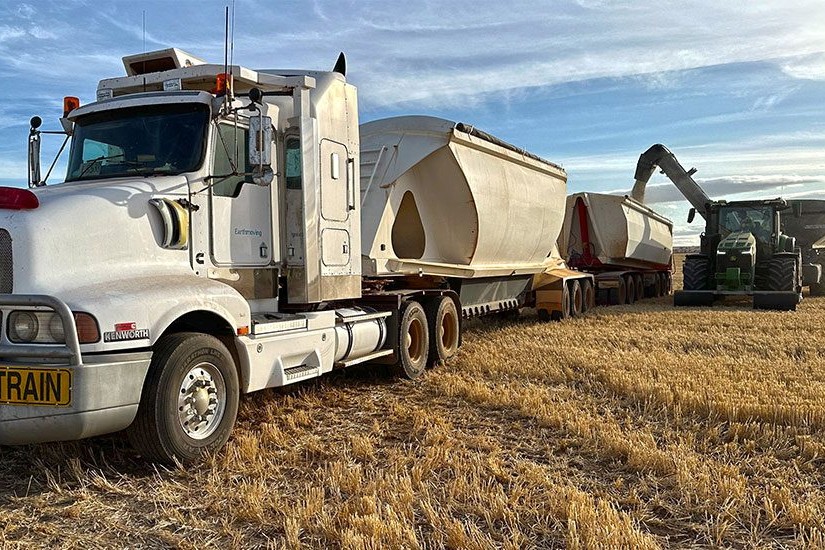AUSSIE ANGLES – KIMBERLEY Crusaders
When you are running a transport operation based more than 2000km from the nearest main truck dealer, your trucks really need to be up to the job. Factor in that they will spend a lot of time on rough outback tracks and your choice is even more limited.
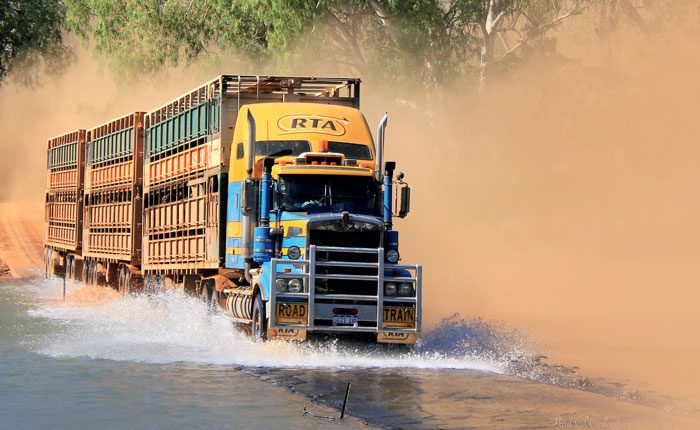
Photo: An RTA Kenworth on the Myroohda, Crossing Western Australia.
Hailing from New Zealand‘s South Island, Glenn Smith has been manager at the Broome depot of Road Trains of Australia since 2003 and he knows a thing or two about running trucks in extreme conditions. Since the arrival of Hampton Transport in northwest Kimberley following their takeover of Road Trains of Australia (RTA) in 2005, Glenn has overseen expansion in the northwest Kimberley region, taking the fleet from four double deck triple trailer road trains to 14. The blue and yellow Kenworths have become synonymous with cattle haulage, having established a reputation for reliable transport in the Kimberley region. The fertile plains of the Fitzroy River have facilitated the growth of large cattle stations across its wild landscape. Indeed, the settlement of Fitzroy Crossing could be regarded as the main hub for the work carried out by RTA. Located 400km east of Broome, a regular run sees the trucks leave the yard throughout the afternoon or evening, ready to load in the Fitzroy Crossing area at daylight. Primarily, the cattle are transported back to Broome for live export, where they are held in feedlots until a ship docks.
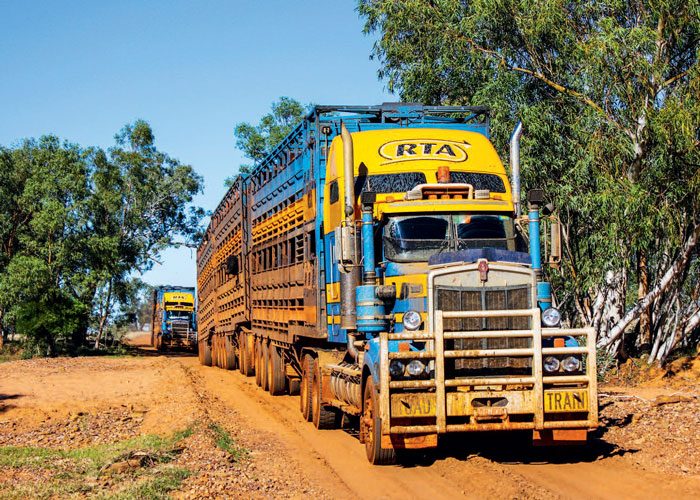
Photo: Australian-built Kenworth trucks are the preferred make for the harsh conditions of Western Australia.
Broome is known for its huge 10-metre tides, something that in the past had slowed the loading of ships – when the ship sits too high or too low in the water, the ramp gradient becomes too sharp. However, modern vessels have various loading points, meaning that there is generally no interruption to loading. These efficient vessels hold 3000 head and can be loaded in about six hours. To see this happening is quite impressive, particularly as the tiny wharf in Broome is not large enough for triple road trains to turn around on, instead, an RTAbranded CAT loader pulls the back two trailers around after they are unhooked from the lead trailer. In a matter of minutes, the trailers are again hooked up and the trucks head back to the export yards for another load. That‘s not to say it is all short runs here. Given there are no significant meat works in the north of Australia, a regular trip sees the trucks load in Broome and head south to Perth, a distance of 2200km. When you factor in washing out the trailers before reloading with palletised feed, each trip takes about a week. Regular runs are also made eastwards into the Northern Territory, either via Kununurra and the Victoria Highway, or along the notorious Duncan and Buntine unsealed tracks.
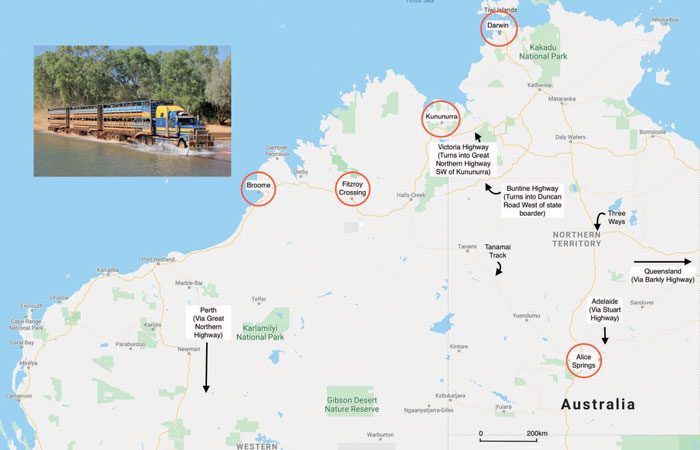
These Broome-based trucks travel far and wide, occasionally ending up as far away as Queensland. But it is work referred to as ‘paddock carting‘ where the trucks really take punishment. These jobs, where a truck is on exclusive contract to a station, can last anywhere from a day or two up to a fortnight, in which time the trucks might not see a bitumen road. Unsurprisingly, they usually return to base with a long list of repairs needed. Subcontractor Paul Slager, a highly experienced auto electrician, immediately deals with electrical issues generally caused by wires rubbing. Even the favoured Kenworths succumb to the harshness of Mother Nature in this remote corner of Australia and nothing is left to chance, with all trucks being thoroughly checked over and repaired before they head out bush again.

Photo: Kenworth T904 on the Tanami Road.
“We can‘t afford to cut corners as it‘s prohibitively expensive to recover trucks once they are out bush,” says Glenn. “If we maintain them properly here, it works out cheaper in the long run.” Neither does Glenn discriminate between the brands. The Western Stars that have joined the fleet in recent years must endure the same punishment and no quarter is given. It is the Kenworth however, that currently holds the crown as the king of outback cattle haulage, and until recently, the Bayswater, Melbourne-built trucks dominated the lineup in the RTA Broome yard. The current line-up includes T904s, T908s, C509s, and a solitary T909. Glenn is a fan of Kenworths, adding that he has ageing T904s that “just keep coming back, season after season”. When asked what his truck of choice is, he replies, “Probably the C509. They are built specifically for the conditions we operate in.” Just as we are chatting, one of the Western Stars heads out the gate, off to load six decks near Halls Creek. There are three Western Stars based in the Broome yard, one from 2015 and two from 2016. The trucks are a darker shade of blue from the fleet standard Hampton blue, and were originally ordered by Heavy Haulage Australia before that firm ran into difficulty. In total, RTA now operates 10 6900 series Stars, all with the largest Stratosphere cab available, domiciled throughout West Australian, Northern Territory, and Queensland depots. Wandering down into the busy workshop, the boilermakers were fabricating their own heavy-duty bonnet mounts for the big Western Stars.
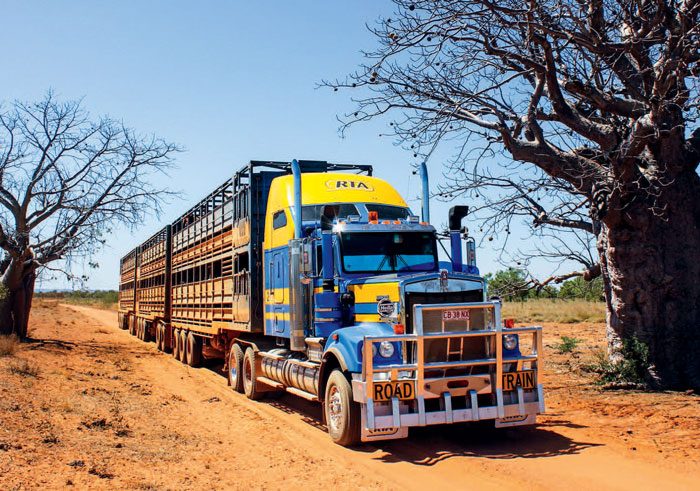
Photo: The Kenworth C509 is the perfect bush truck. “Built specifically for the conditions we operate in,” says Glenn Smith.
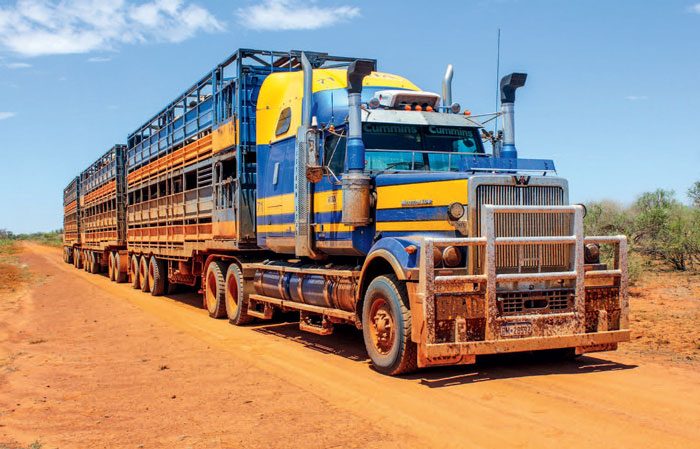
Photo: Western Stars working as hard as they will anywhere else on earth.
“The original ones have been replaced and keep getting flogged out, so we‘ll see how these ones work out,” says Glenn. In an effort to reduce the damage caused by vibrations on corrugated dirt roads, all trucks are equipped with ‘spider‘ air lines. This allows four drive tyres to be inflated or deflated at the same time, although two of the 509s driven by long-serving drivers are equipped with Aussiedesigned CTI (Central Tyre Inflation), controlled by a dial on the dash. Interior-wise, the Western Stars are cavernous and beat the Kenworths hands-down for living space. “The guys who have them love them,” says Glenn. “They have an upright fridge, which we didn‘t want, but that‘s just how they came”. The upright fridge is basically the same as the household design and just about every one has failed. Chris Hansen, originally from Waikaka (also in New Zealand‘s South Island) drives Western Star No. 47, and says, “I never use that fridge now, it‘s too unreliable. We all have 45-litre Engels, and I can still walk around it even though I have it placed between the seats.” The shorter gear sticks in the Stars were also a source of annoyance: “The gear stick is too low, so I‘ve put an extension on which makes changing much easier,” says Chris.
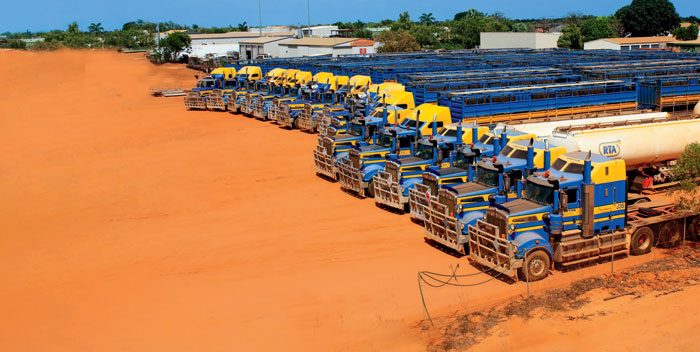
Photo: RTA Broome Fleet 2017.
All of the trucks are well specced, and RTA was the first to run the big 60” bunks behind their Kenworth T904s back in 2007. Icepack secondary air conditioning systems are standard fare when operating in the North of Australia, going hand in hand with 2000-watt inverters, fitted to allow drivers to run microwaves and kettles etc. HID (High Intensity Discharge) and LED headlights and spotlights have become commonplace, even on the older trucks. Anybody who has travelled the Great Northern Highway east of Broome at night will testify to the need for good lighting power up front! Both the Kenworths and Western Stars have Cummins engines set at about 448kW (600hp). While this does sound like a modest power output, the trucks pull admirably well, and longevity of engine life is paramount. The current generation of ISXe5s have been performing well, and are certainly more reliable than the EGRs they replaced by all accounts. For pulling power though, it is the old Signature Gen-2 motors which have the upper hand, according to some of the drivers.
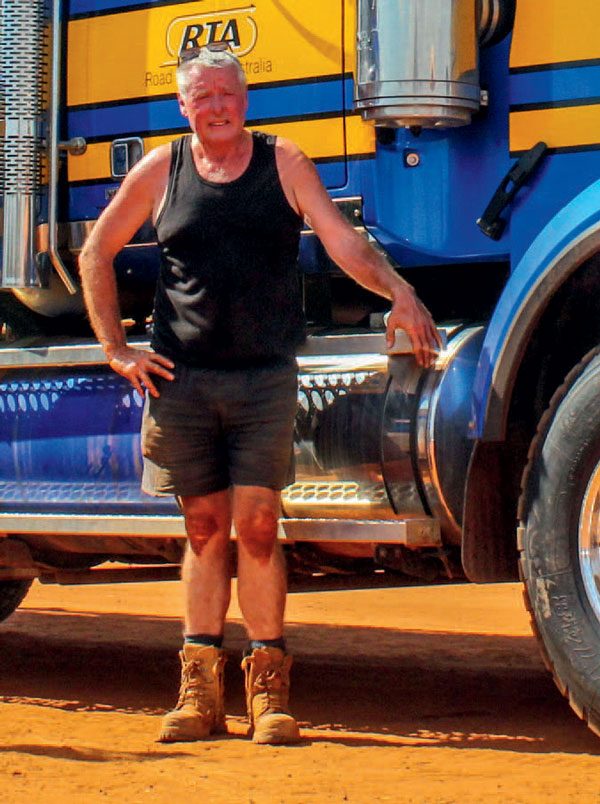
Photo: Hailing from Waikaka in Southland, Chris Hansen has done 10 seasons for RTA.
Aside from major work like engine transplants and electrical work, everything else is handled by in-house mechanics and boilermakers. Pounding roads mean that there will always be one trailer in the welding bay for repairs. “We buy the toughest trailers available, then rebuild them when necessary,” says Glenn. “That set over there is 30 years old, although you would never tell apart from the old style chassis design, which looks tough enough to last another 30 years.” Rebuilds are done in-house, while resprays are carried out in Perth, also done by company-employed painters. In terms of configuration, a 7-deck unit was briefly trialled with a permit in the 90s, but was eventually abandoned. Adding an extra A-section means drawbars and run throughs need to be shorter to keep the outfit within the length restrictions, meaning interchanging with other fleet trailers isn‘t possible. Also, with rough creek crossings and steep jump-ups, the work doesn‘t really suit the setup, which adds a lot more drag. In the cattle haulage game, you need to be in it for the long haul and roll with the ebbs and flows of a constantly changing tide. “Every season is different. One year we might have a big wet and not start shifting cattle until April. The following season, if it‘s dry, we may begin in early February,” says Glenn.
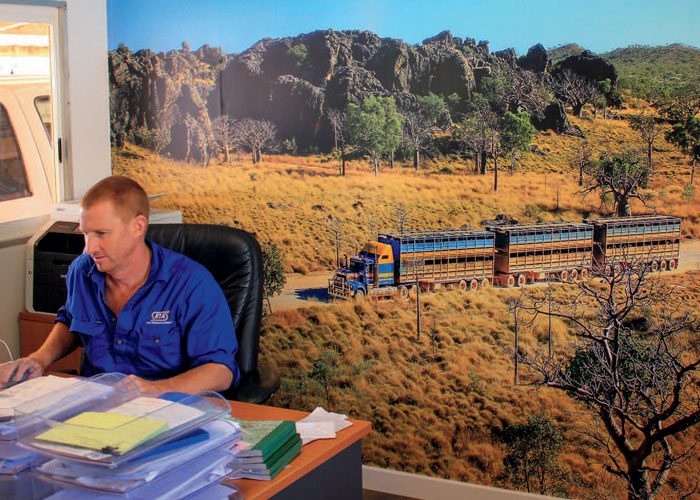
Photo: Originally from New Zealand‘s South Island, Glenn Smith has been manager of RTA‘s Broome operation since 2003.
“We are always on the lookout for good drivers. I‘ve had some great drivers come over from New Zealand over the years. Chris Hansen for example, has done 10 seasons here. It suits Kiwis as you can escape the New Zealand winter, then return home for the summer. While some may find it a daunting prospect or think they wouldn‘t be up to the task, I‘d encourage anyone who‘s interested to give it a try. It‘s all about having the right attitude here and being willing to learn. Accommodation is provided and we have a couple of Toyotas that the drivers can use.” In an industry constantly facing challenges, it‘s a delicate balancing act between moving with the times and keeping abreast of legislative requirements, while still staying true to the outback traditions that are associated with the iconic Road Trains of Australia brand. One thing is for sure though, the famous blue and yellow cattle trucks that have been plying the tracks of the Kimberley for the past 25 years will be at the forefront of whatever lies in store for the future.
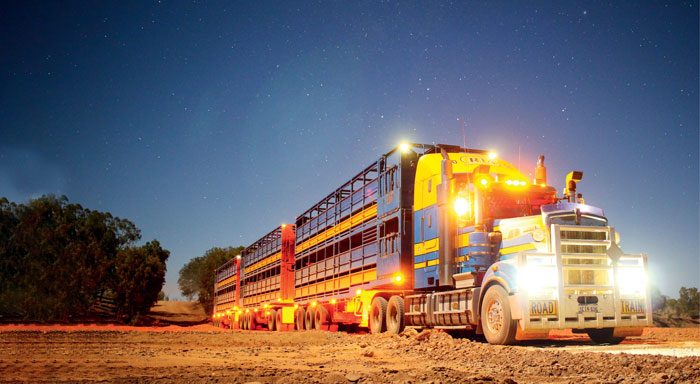
Read more
Mack Muster a must
0 Comments6 Minutes
Decks to Darwin
0 Comments1 Minutes





